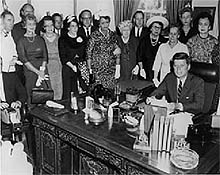 Just about the most mundane thing to populate media lately has been the claims of the end of men. Even so, two weeks ago, I attended a useful conference at Boston University Law School on “investigating the claims of the end of men.” The subject of the conference was taken from the title given an article that led to a book by journalist Hanna Rosin. Rosin’s upshot is that women are gaining in the work place and in leadership; from this claim Rosin has helped to fuel a perception among some men and some commentators that men are losing ground. (The image above is JFK signing the Equal Pay Act, June 10, 1963.)
Just about the most mundane thing to populate media lately has been the claims of the end of men. Even so, two weeks ago, I attended a useful conference at Boston University Law School on “investigating the claims of the end of men.” The subject of the conference was taken from the title given an article that led to a book by journalist Hanna Rosin. Rosin’s upshot is that women are gaining in the work place and in leadership; from this claim Rosin has helped to fuel a perception among some men and some commentators that men are losing ground. (The image above is JFK signing the Equal Pay Act, June 10, 1963.)
Why am I so down on these claims? Stephanie Coontz skillfully analyzes many of the reasons in “The Myth of Male Decline.” Check out Nancy Folbre’s quick summary at the Economix blog today, and she explains: “The men-in-decline issue can’t be reduced to numbers, but in a comprehensive critique in The New York Times, Stephanie Coontz highlights misleading inferences drawn from a marketing-firm study of several metropolitan areas showing that never-married childless women in their 20s out-earn men in the same category.” (After you read Coontz, then read Folbre, and follow up on her fun review of Philip Cohen’s debunking of the end of men!)
Let me add another piece of evidence released after Stephanie’s piece appeared in The New York Times. The American Association of University Women’s October 2012 study, “Graduating to a Pay Gap” (.pdf) found that one year after college graduation, women earn 82 percent of what men earn. As Nancy Folbre noted, “While young women are more likely than young men to graduate from college, their diplomas don’t generate equally rich rewards.”
The AAUW study found a few factors could account for part of the gap, but about one-third of the difference could not be accounted for. Some of that 18 percent gender gap is explained by choice of major. Men major in fields that lead to higher pay. This isn’t a signal that the difference is fair, or natural, or justified. It just tells us that there is a system of what would otherwise by arbitrary differences between men and women that makes it easier for some people to maintain a sense that gender difference in pay “just happens.”
Think about this: The proportion of women in computer science went up to 37 percent in 1985. Then it went down to 22 by 2005. That kind of swing isn’t nature (as in the conversation-ending claim that it is just natural that boys and girls have different preferences). That is something else….
Some of the gap is explained by occupation. Men are in higher paying occupations. Keep in mind: the reasoning here is a bit circular: are men in higher paying occupations? Or is it that occupations with a high share of men are better paying? A little bit of the gender gap is explained by differences in hours worked. Women averaged 43 hours per week, men 45 hours per week in the study.
None of these factors are signals that men and women are different, but that the world is different for them. So that leaves the “unexplained” part of the gap. The executive summary of the study offers this description:
Consider a hypothetical pair of graduates—one man and one woman—from the same university who majored in the same field. One year later, both were working full time, the same number of hours each week, in the same occupation and sector. Our analysis shows that despite these similarities, the woman would earn about 7 percent less than the man would earn. Why do women still earn less than men do after we control for education and employment differences?
The authors suggest that discrimination, including bias against women in negotiations (employers appear to respond to women’s negotiating attempts less favorably and to men’s negotiating attempts more favorably), might explain some of it. Tell me about it. I keep saying it: inequality is sneaky. But it isn’t subtle.


Comments
Alice Paul — October 30, 2012
Unequal pay is only a problem if you're a woman, married to one, or care for one. The complaint form for Illinois is at: http://www.state.il.us/agency/idol/forms/PDFS/IL452EP01.PDF
I believe the massive pay disparity contributes to women having two full time jobs. Either two paying jobs in the work force to try and stitch together a good living for their family or alternatively one paying job and another 40 hours of care for their families at home.